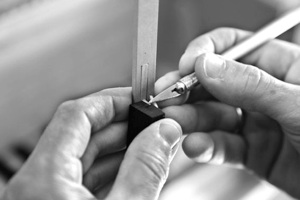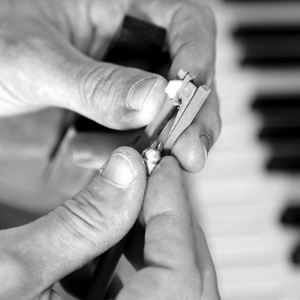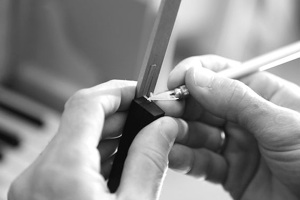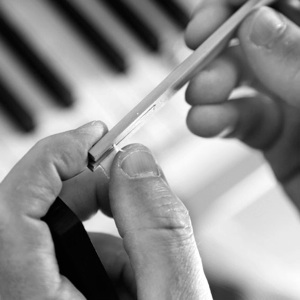VOICING

THEORY
It is the plectrum that bends to later pluck the string when you play a note. The way the plectrum will pluck depends on how you play the key and of what material the plectrum is made. It is a crucial element in the sound production.
Roughly there are two kinds of plectra: quill (bird feather) and plastic (delrin and celcon). (1: Leather and brass exist as well but they are rare. 2: I prefer delrin over celcon.)
Both materials, delrin and quill, have advantages and disadvantages.
Quill:
-
‣ used historically
-
‣ cleaner and clearer sound
-
‣ lighter touch with more control
-
‣ easier to cut properly
-
‣ not very sensitive to the amount the plectrum surpasses the string
-
‣ staggering can be very little which results in less key dip
-
‣ wears out faster than very well cut delrin
-
‣ sensitive to humidity changes
-
‣ needs some care, once or twice per year a little bit of oil and checking the points before an important event
-
‣ depends where you live, more difficult to get
-
‣ it usually won´t break abrubtly but it will become weaker (you probably can finish the concert)
Delrin:
-
‣ well cut it should last more than 10 years
-
‣ basically insensitive to humidity changes
-
‣ easily available
-
‣ hardens in the first weeks after it is cut (due to ultra violet light)
-
‣ it will break without warning
-
‣ very sensitive to the amount the plectrum surpasses the string, this can in modern times also be an advantage: by moving the register a bit you van make the instrument louder or softer
Cutting delrin:
What you need is a very sharp knife, a cutting block, pliers that are smooth on the inside (the side that will grab the plectrum), a little screwdriver and delrin - voicing_tools.jpg.
Delrin comes in plates, strips, pre-cut (cut to shape but not pre-voiced by the thickness) and pre-voiced. Since delrin has a direction I would buy either strips or pre-cut plectra (www.vogel-scheer.de). I would avoid cast delrin (¨pre-voiced¨ delrin); it breaks very easily. Apart from this it is sold in two thicknesses: 0,4 mm and 0,5 mm.
If you want to have some more technical information I refer to the web site of Marc Vogel.
What you should know before you begin:
-
‣ use a very sharp knife (I can not stress this enough). I strongly advise against using a file, scraper or sandpaper (they leave a rough surface by which the plectrum will break more quickly)
-
‣ cut the plectrum when it is in position in the jack with its top side (the side that touches the string) being on the cutting block
-
‣ always cut the underside of the plectrum, the top side should stay untouched.
-
‣ make straight cuts away from the tongue
-
‣ towards the tip the plectrum should get gradually thinner (this is very important, the finished plectrum should bend parabolically. You can test it by bending the plectrum with your finger)
PRACTICE






Cut the plectrum to length with a cut to the front.
To control the movement of the knife hold your hands together (the middle and ring finger of my right hand are continuously in contact with the fingers of my left hand and the cutting block).
For 4´ or upper manual 8´ I normally use narrower plectra. For all other registers you can skip this and the next step.
Remove some material from one side of the plectrum by making small cuts from tongue to tip.
Make some small cuts backwards to the tongue and lever the material off. Avoid making a cut from right to left (parallel to the tongue) to remove this material.
(Note that my right hand is touching the jack to control the cut)

You can check the result by bending the plectrum with your thumb. It should bend parabolically.
Now put the jack in your harpsichord, cut it to its proper length and play the note.
If it is too loud repeat the steps: cutting the shoulders and cutting the centre till you are satisfied with the result.
If it is too soft: push the plectrum from the back of the tongue with a small screw driver, cut a bit off the tip and try again.
If you can´t get it loud enough you probably used 0,4 mm delrin where you should have used 0,5 mm.
Remove the ¨shoulders¨ of the plectrum (to make the cross-section more or less trapezoidal) with straight cuts from tongue to tip. (hold the knife almost vertically)
This is easier than to make a cut over the entire width of the plectrum.
(Again, keep your hands touching each other and the block)
Remove material between the ¨shoulders¨. Start with a cut at 1/3 of the plectrum length from the tip, make a second cut beginning at about 2/3 from the tip and a last one from tongue to tip. This way you made a tapered plectrum.
Complete cuts can only been made with a very sharp knife and with a bit of experience. In the beginning try to make a straight line even if it involves several small cuts
TO BE CONTINUED
